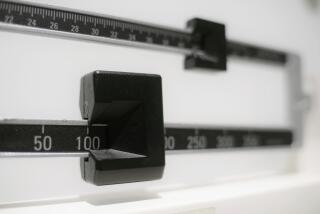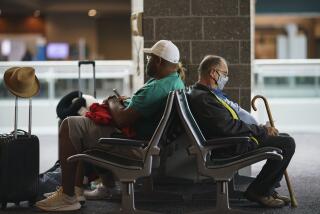TRAVELING in style : Circadian Clockwork : An expert’s list of shortcuts for easing the malady of jet lag.
- Share via
You probably know the feeling. Dizziness. Confusion. Inability to sleep. Aching muscles. Moodiness. Digestive discomfort. No, it’s probably not the flu. More likely, it has something to do with the trip that you have just completed. Whether two, four or 15 hours away, every time-zone changed brings with it the potential for increased discomfort. Scientists call it “transmeridianal malaise” but it’s plain jet lag to everyone else.
Jet lag was born with advances in travel technology. In the early 1960s, we world travelers were still using those grand ocean liners to do the bulk of our transoceanic travel. It was, after all, the civilized way. Part of the pleasure was that it took so many days to get from one point to another. Indeed, you had already arrived in a very special place, once you boarded such a ship. These were floating palaces--places to relax for 10 days, to write books, to socialize with new-found friends and to do so with no sign of transmeridianal fatigue. But gradually through so-called “progress,” these slow-paced, sea-going palaces lost many of their passengers to aircraft that became faster and faster as time marched on.
As recently as the early 1960s, the four-engine, propeller-driven plane took about 17 hours to travel from New York to Paris. Then came the jets, which require seven hours for the same trip. Now we can do the New York-Paris flight on the Concorde in 3 hours, 45 minutes.
Lucky for today’s traveler, the speed of research into the science of circadian, or body rhythms, and the nature of the body’s clock almost kept pace with the speed of international travel. In 1960, science had recognized only a single factor capable of resetting the body’s clock. It was light. But by the end of the 1970s, the link between jet lag and confused biological clocks had been accepted, and a variety of other clock resetters were identified.
In working on “clock resetting” experiments at Argonne National Laboratory near Chicago, my colleagues and I found that the best way to combat jet lag was to use several of these clock resetters together. Thus, the jet lag diet was born and I published “Overcoming Jet Lag” with Lynne Walter Scanlon (Berkeley Books). At Argonne, a research center specializing in the study of peaceful uses for nuclear energy, including biological forms of energy, we prepared and distributed nearly half a million copies of wallet-size cards outlining “The Argonne Anti Jet Lag Diet.”
Throughout the 1980s, the public appetite for more information on overcoming jet lag rose with our globe-trotting ways. As we enter the ‘90s, what advice can we offer the traveler who wants to avoid or at least minimize the symptoms of jet lag? For starters, jet lag usually lasts only about a day per time zone. Yet it’s easier to adjust to new time zones going west than east because, very simply, it’s easier to slow down the biological clock than to speed it up. Yet this can be of small comfort to someone who hasn’t captured a full night’s sleep for three days running. It makes more sense to prepare in advance and avoid the symptoms to the best of our abilities.
To that noble end, here are 12 tips:
1. Health. Leave home well rested, physically strong and mentally alert, with your body clock strongly set in home time and your body in the best working order. Avoid extra chores, late-night work, last-minute shopping sprees and endless bon voyage parties. A 15-minute cushion of extra sleep before and after your usual eight hours per night can add to your feeling of well being if indulged in for three or four nights before a trip.
2. Itinerary. Plan your itinerary carefully; avoid too much zigzagging across time zones. If you can avoid it, don’t arrive at your destination later than midnight, especially during the “circadian pits” (from 2 to 4 a.m.). Try to choose flight schedules that get you there after breakfast and before 8:30 at night so that you have time to settle in and enjoy your night’s accommodations before sleep-onset time.
3. Dress. Travel in comfort. Wear soft, loose-fitting garments and shoes and take along a suitably-equipped travel kit. The kit should contain a pair of eye shades and ear plugs to shut out light and noise and a soft pair of slippers to slip on during the flight. The kit should also include a small food reserve containing high-protein granola bars, cheese and crackers or a small carton of yogurt. High protein foods are needed because they tend to stimulate the get-up-and-go part of our metabolism.
4. Alcohol. At high altitudes in dry, pressurized air cabins drink plenty of water. This will help you ward off the effects of dehydration. Avoid drinking too much alcohol since it, too, can cause dehydration. Select a window seat on the side of the aircraft where sunrise or sunset will be most visible. This will help you use light to reset your body clock. Wear two watches, one on home time, one on destination time and switch to the latter as you enter the aircraft on the trip home, sleep and eat on destination time.
5. Meals. Try to begin regulating meals two to four days before departing on your trip. The goal is to control not only the food you eat, but other clock-resetting cues, such as light, exercise and social stimulation. The eating pattern should run: one day of feasting, one of fasting, followed again by a feast day and then a fast. Feast days should be high-protein breakfasts and lunches and high-carbohydrate suppers. They should be high in calories--perhaps 1,000 more calories than you would eat during a normal day. Fast days should also contain high-protein breakfasts and lunches and high-carbohydrate suppers but they should be low in calories--perhaps as low as 700 for the entire day.
6. Foods. The kind of food you eat--whether it is relatively high in protein or in carbohydrates--is of great importance. This is true because high-protein meals stimulate metabolism, a normal state for your body clock during the morning hours, while high-carbohydrate meals encourage sleep onset. Sugar cereal and sugar drinks for breakfast thus tend to tell you to “go back to sleep again,” while a steak and eggs breakfast (or a lower-in-cholesterol equivalent) is actually just what you need.
7. Caffeine. Consume caffeinated beverages only at prescribed times: Between 3:30 p.m. and 5:30 p.m. for the first three days you are regulating your behavior. Do not drink any caffeine in the early morning or late evening. Then on the last day before the flight, drink caffeinated beverages only on this schedule: If you are traveling west, consume caffeine only between 7 a.m. and noon. If you are traveling east, only drink caffeine between 7 p.m. and midnight.
8. Other drugs. Be aware that in addition to caffeine, many other drugs found in coffee, tea and cocoa (theophylline and theobromine, for example) are clock resetters. Other drugs that can effect clock resetting are several of the prescription drugs for anti-hypertension, corticosteroids and psychotropics. If you are taking any of these, don’t quit, but be sure to consult your physician for proper time changes for your trip. It could be unhealthy for you to alter your schedule without your doctor’s advice. Although a number of dietary supplements, drugs and sleeping pills are sometimes recommended as jet-lag cures, I cannot recommend any as beneficial at this time. Some even have harmful side effects.
9. Light. Use light to help you make the jet-lag adjustment. It’s a powerful clock resetter in all living things. Light used immediately before and during embarkation may be difficult to apply correctly but the following rules should be followed: Two to four days before and for the first three days after a trip, during normal living, enjoy plenty of bright light every day, preferably outdoors. Be sure that your sleeping quarters are dark at night. On the day you arrive at your destination, if your flight was eastbound, get plenty of outdoor bright light throughout the morning. Wear sunglasses in the afternoon if outdoors. If your flight was westbound, get plenty of outdoor bright light only during the afternoon.
10. Exercise. Each day get plenty of exercise during the active phase and rest and relaxation during the inactive phase. On flight days at destination wake-up time just before breakfast, pace the aisles of the aircraft or do isometric exercises at your seal. When you reach your destination, do lots of walking before and after each meal, every day.
11. Oxygen. Include deep breathing with exercise and make a special effort to move lots of oxygen through your lungs. Where space permits, jogging or other aerobic exercise is good. Avoid smoking areas where air pollution levels are high. Oxygen is a powerful clock resetter.
12. Socialize. Use social cues to your advantage. These include talking and dining with friends. On eastbound transatlantic crossings when it’s time for sleep, simply tell your seatmate about your anti-jet lag program and invite him or her to join you in lively conversation and breakfast, too, when the flight attendant brings you your high-protein snack (at your special request) a few hours before landing. Taken together with meal timing, social cues can be the glue that binds clock resetters together. When you arrive in Paris or Rome, lunch with friends al fresco and avoid the impulse to gobble a room-service meal in the lonely darkness of your hotel room. Get some exercise before and after lunch and avoid naps until bedtime, which should be 15 minutes earlier than usual.
And above all, in the words of Robin Williams in Dead Poet’s Society: Carpe Diem! Seize the day!
For a free copy of “The Argonne Anti Jet Lag Diet,” send a stamped, self-addressed envelope to: Office of Public Affairs, Argonne National Laboratory, Argonne, Ill. 60439.
More to Read
Sign up for The Wild
We’ll help you find the best places to hike, bike and run, as well as the perfect silent spots for meditation and yoga.
You may occasionally receive promotional content from the Los Angeles Times.






